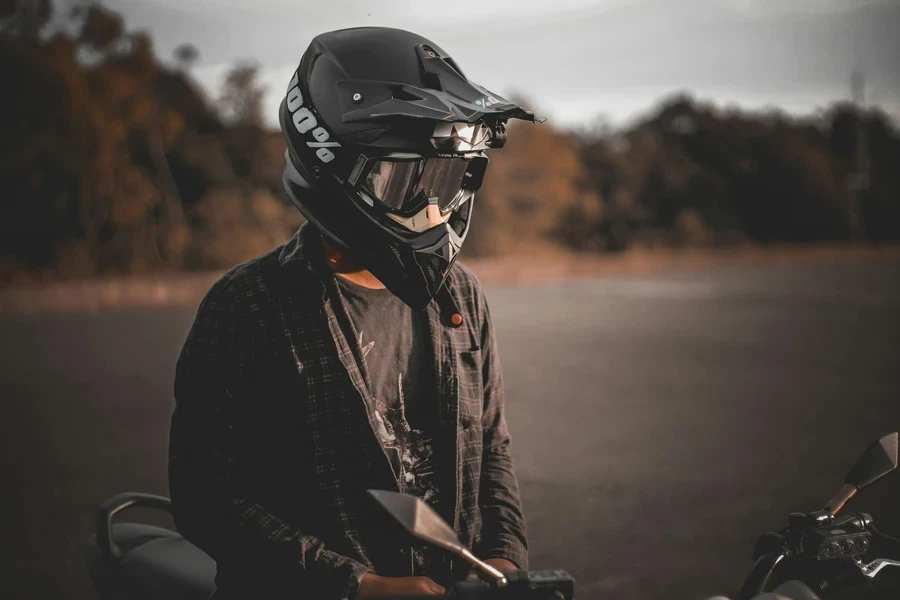Table of Contents
● Introduction
● Market overview
● Things to consider when selecting motorcycle helmets
● Models and their features
● Conclusion
Introduction
Choosing the right motorcycle helmet is crucial for ensuring both safety and comfort on the road. As the number of motorcycle enthusiasts continues to rise, the demand for high-quality helmets that offer superior protection and enhanced comfort features has never been greater. A well-fitted helmet not only safeguards against head injuries in the event of an accident but also enhances the overall riding experience through advanced features like noise reduction and better airflow. With technological advancements, today’s helmets are more than just protective gear; they integrate elements like Bluetooth and built-in cameras, catering to the modern rider’s needs. For any rider, selecting the suitable helmet is a fundamental step in preparing for safer and more enjoyable journeys.

Market overview
According to Grand View Research, the motorcycle helmet market is experiencing significant growth, underscored by a compound annual growth rate (CAGR) of 6.8% from 2023 to 2030. This market’s expansion is driven by rising road safety awareness and an increasing number of motorbike and sports bike enthusiasts. The market size, which was valued at USD 2,287.1 million in 2022, reflects an upward trajectory fueled by these factors and the introduction of new technologies aimed at enhancing rider safety and convenience.
Emerging trends in the market emphasize the integration of advanced technologies such as Bluetooth connectivity, GPS navigation, and augmented reality features, which display vital riding information directly on the visor. This technological integration is revolutionizing the way helmets are used, shifting them from mere safety gear to essential smart devices that enhance the riding experience while improving safety. The focus on meeting stringent safety standards also highlights a shift towards higher consumer expectations and knowledge about protective gear. As reported by Grand View Research, these trends are set to shape the future of the motorcycle helmet industry.

Things to consider when selecting motorcycle helmets
Head size and shape
It’s crucial to select a helmet that fits the head size and shape correctly. Helmets come in various shapes, such as round oval, intermediate oval, and long oval. A properly fitting helmet will not put undue pressure on any part of the head, will prevent excessive movement, and will smoothly pull the skin of the face and scalp when being removed. This ensures that the helmet stays secure in the event of an accident.
Retention
A helmet’s ability to stay securely on the head in extreme conditions is a critical safety factor. To test this, one should fasten the helmet’s strap and try to roll the helmet off by pulling it upward from the back. A helmet that stays in place is essential, as those that come off easily offer little protection in a crash.
Visor
The visor on a motorcycle helmet is a critical safety feature, providing protection against wind, dust, debris, and insects, which are common distractions or hazards during rides. It ensures clear vision, which is essential for safe riding. Visors come in various tints and coatings, such as clear for night or low-light riding, and tinted for bright conditions to reduce glare. Some are equipped with anti-fog and anti-scratch coatings to maintain visibility and durability. Choosing a helmet with a high-quality visor that offers easy swapping mechanisms can greatly enhance riding comfort, allowing riders to adapt quickly to varying lighting and weather conditions, while a well-sealed visor helps minimize wind and noise intrusion at high speeds.
Proper cushioning and material
Proper cushioning and material selection are essential for the effectiveness of a motorcycle helmet, impacting both safety and comfort. The interior cushioning, usually made from expanded polystyrene (EPS) foam, is designed to absorb and dissipate forces during impacts, protecting the brain and skull. This foam varies in thickness and density across different parts of the helmet for optimal protection. The outer shell, constructed from materials such as polycarbonate, fiberglass composite, or carbon fiber, also plays a crucial role in safety. Carbon fiber is particularly valued for its high strength-to-weight ratio, offering superior protection without the burden of extra weight, thus minimizing rider fatigue on prolonged rides. When choosing a helmet, ensuring that both the cushioning and the materials used adhere to safety standards is vital for maximum protection and comfort.
Safety standards and certifications
Helmets should meet or exceed standards set by organizations such as the Department of Transportation (DOT) and the Snell Memorial Foundation. These certifications ensure the helmet has undergone rigorous testing for impact resistance, penetration, retention, and peripheral vision. Helmets with these certifications are proven to provide reliable protection during various types of impacts.
Material and construction
Advanced materials such as carbon fiber and fiberglass are used to enhance helmet safety and reduce weight. According to Bikester Global, these materials are chosen for their high strength-to-weight ratios, providing substantial protection without the bulk, which helps in reducing rider fatigue.
Comfort and fit
A properly fitting helmet should be snug but not tight, without causing pressure points or discomfort. It should also remain securely in place during a crash. Adjustable features such as padding, chin straps, and ventilation systems are critical for a good fit and essential comfort. Adequate ventilation not only enhances comfort but also prevents visor fogging, maintaining clear visibility.
Additional features
Modern motorcycle helmets often incorporate advanced technologies that enhance safety and usability. Features like Bluetooth connectivity allow for seamless communication, enabling riders to make calls and listen to music without compromising attention to the road. Integrated cameras in helmets provide the capability to record trips, which can be useful for capturing scenic routes or providing evidence in case of incidents. Additionally, enhanced visibility features, such as reflective materials and built-in LED lights, significantly improve safety during night rides or in low-light conditions. These technological integrations transform traditional helmets into multifunctional gear suited for the modern rider’s diverse needs.

Models and their features
Top full-face helmets
Full-face helmets are highly regarded for their extensive protection as they cover the entire head and face. Renowned for their robust safety features, these helmets often include advanced technologies such as Bluetooth connectivity and adaptive visors that respond to varying light conditions. Suitable for riders who place a premium on safety, full-face helmets offer significant peace of mind during high-speed adventures and long-distance rides, ensuring both protection and comfort.
Open-face helmets (half-face)
These helmets provide coverage for the top and back of the head while leaving the face exposed, offering more breathability and visibility. They are popular among city riders and those who prefer shorter, less intensive rides. While they offer less protection than full-face helmets, they provide greater comfort in warm climates and a sense of openness, making them a favored choice for leisurely rides.
Half-shell helmets
Often chosen for their minimalist design, half-shell helmets cover only the top of the head, providing the least protection but maximum freedom. These helmets are suitable for riders who prioritize comfort and a lightweight option for quick trips or specific low-risk driving environments. However, their limited coverage means that riders must be particularly cautious, as the protection offered is minimal compared to more comprehensive models.
Leading modular helmets
Modular helmets provide a suitable combination of safety and convenience, with a chin bar that can be flipped up to quickly transform the helmet from full-face to open-face. This feature makes modular helmets a favored option for riders who value flexibility. They merge the protective qualities of full-face helmets with the accessibility and ease of communication typical of open-face helmets, appealing especially to touring enthusiasts who need to frequently engage in face-to-face interactions or converse without removing their helmet.
Helmets for off-road adventures
Off-road helmets are meticulously crafted to meet the challenging demands of off-road riding, featuring an extended chin bar and a broader visor to enhance airflow and reduce heat buildup. These helmets are typically made from lightweight materials such as carbon fiber, kevlar, or fiberglass, which help minimize weight while maximizing strength and durability. Such characteristics are essential for riders navigating tough terrains, ensuring both safety and comfort during rigorous off-road adventures.
Smart helmets
The integration of technology into motorcycle gear is particularly apparent in the development of smart helmets. These innovative helmets come equipped with advanced features such as GPS navigation, voice control, and connectivity options, enabling riders to make calls, listen to music, and receive navigation cues without compromising on safety. Enhanced with LED communication strips, HD cameras, and VOIP intercoms, smart helmets enhance the riding experience by providing both increased convenience and improved safety, making them a top choice for tech-savvy riders.

Conclusion
Selecting the right motorcycle helmet is crucial for ensuring safety, comfort, and functionality, tailored to individual riding styles and needs. With a wide range of options available in the market, riders can find helmets that align with their specific requirements, whether for urban cruising, off-road adventures, or long-distance touring. It is essential to prioritize safety features alongside innovative enhancements, ensuring that aspects like advanced impact absorption, secure fit, and optimal visibility are considered. This careful selection process allows riders to enjoy the thrill of their journeys with the assurance of superior protection.




